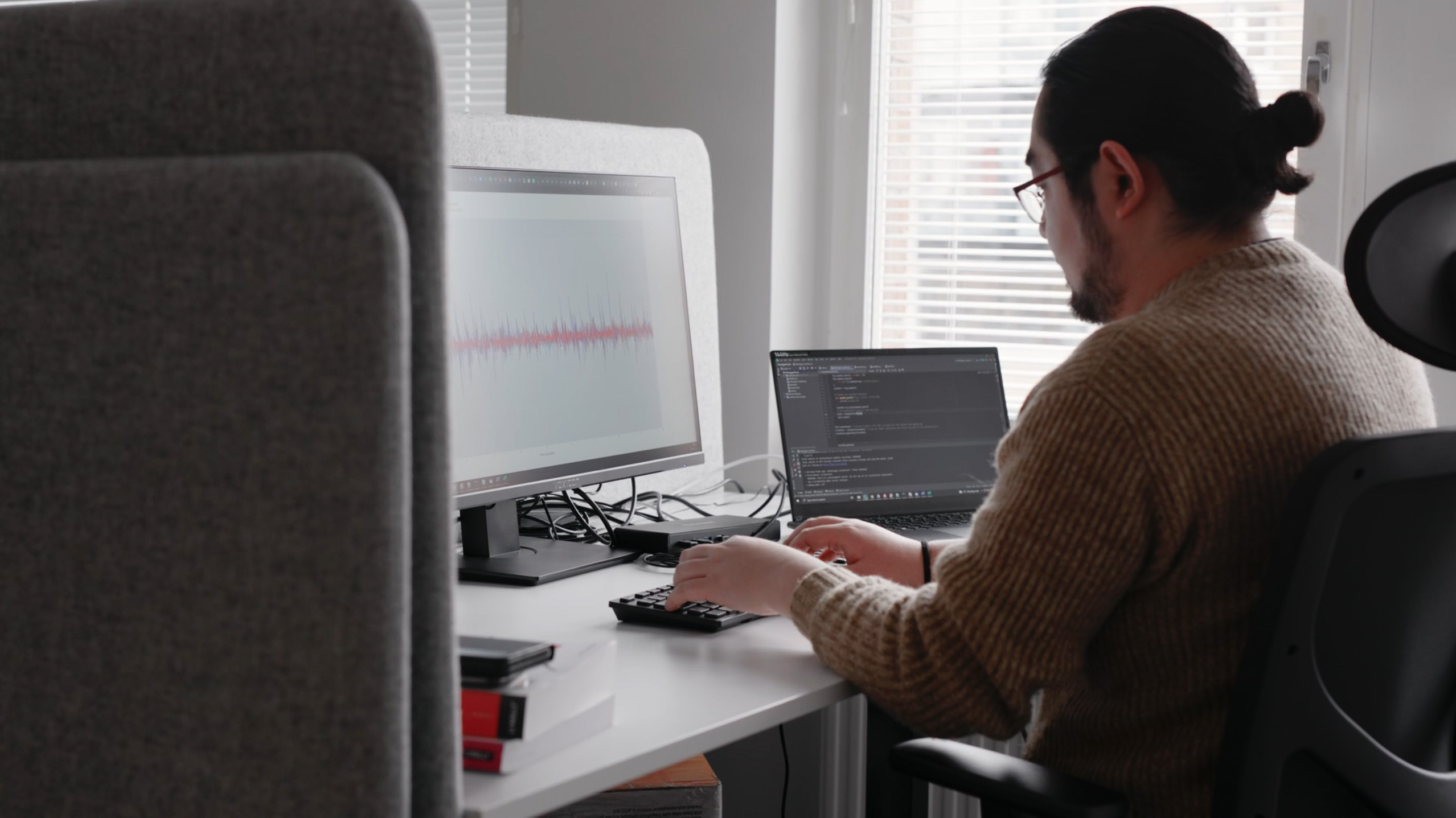AI and Machine Learning at RMD
Railway Metrics and Dynamics is digitalizing the railway industry by developing AI and Machine Learning-based sensors that operate together in a “system of systems.” But how exactly does Machine Learning technology work – and what makes RMD’s systems and products so unique? Here’s what our AI and Machine Learning expert, Bonny Wong, has to say.
In Railway Metrics and Dynamics’ new facility at Övre Gärdet, our expanded Machine Learning Lab is being set up. This is where all the sensor data from customers in Sweden and all over the world is collected. Our powerful servers are also housed here, where we can run advanced simulation models on world-class licensed software.
About AI and Machine Learning
Machine Learning and AI are closely related fields, focused on creating systems and algorithms that learn from data, and then perform tasks that usually require human intelligence.
Machine Learning is a subset of AI that focuses on giving computers the ability to learn from data – without being explicitly programmed for each task. Instead, it uses algorithms and models that are trained on large amounts of data to identify patterns and make predictions. These models have the ability to improve their performance over time based on experience.
AI, on the other hand, is a broader concept that involves creating intelligent systems capable of reasoning and making decisions. Machine Learning is a technique used to develop these intelligent systems by allowing them to learn from data.
Why is a large dataset important?
– Machine Learning models learn by analyzing large datasets and identifying patterns. If the dataset is too small, poor in quality, or not representative, training issues arise. This is especially important in niche industries like the railway sector. A model can either become overfitted – meaning it’s overly tailored – or underfitted, leading to poor performance.
– It’s about generalization. The more diverse and comprehensive the dataset is, the better the model can generalize in new, unknown situations. If the data contains errors or isn’t broad enough, the model cannot make the right decisions – because it simply doesn’t have all the facts. The model will perform poorly in real-life situations.
– There are two basic requirements that must be met: the dataset must be correct, and it must be comprehensive.
Where does RMD’s data come from?
– In a niche industry like the railway sector, the data you want is very rare. What makes Railway Metrics and Dynamics unique is that we collect our own data. The sensors we’ve delivered to our customers, both in Sweden and abroad, continuously generate data, which is stored with us at RMD.
– In one of our projects, we’ve been collecting data since 2022 from an MB locomotive where our PMU sensors are installed. This vehicle is used in traffic throughout Sweden, particularly on the Falun-Gävle route. Each measurement the train takes on its journey generates approximately 1,500 data points per second – and per sensor. Since the project began, we’ve collected hundreds of gigabytes of data points.
– Our PMU sensors are unique because they measure continuously without interruption. They transmit information non-stop. Together, they provide an enormous amount of real-world data – the kind no one else has access to.
– RMD’s models and algorithms are based on an enormous dataset that is both quality-assured and specific to the railway industry, which is truly unique.
How is the data quality-assured?
– Before the data can be used in a Machine Learning model, or for analysis and reports, it must be refined. RMD spends a lot of time sorting and filtering out the right information.
– There are many ways to remove “noise.” Speed is a parameter you can look at, as slower trains often deliver less relevant data. Switches often generate a lot of shaking and vibrations. Level crossings and other fixed objects can also be filtered out. And we know where all these objects are located thanks to the Swedish Transport Administration’s open data sources.
– With the help of background information and our own railway expertise, we ensure that the data we use is as clean as it can be.

“Our simulations are an important tool”
– In addition to our vast amount of real-world data, we gather even more by running simulations. But before a simulation can begin, some initial setup work must be done, including modeling the specific vehicle to be simulated. During the simulation, we use the output data to develop our algorithms, analysis methods, and Machine Learning models. To refine things further, we can feed real measurement data into the simulation to see how it behaves.
– This way, we calibrate the simulation until the outcome precisely matches reality.
– Then we can “tweak the settings” by feeding in different parameters. This can include track faults, train composition, load weight, locomotive condition, speed, and a variety of other variables. Through the manufacturers, we know in advance the weight of the wagons and locomotive, what type of suspension is used, and how a particular bogie type performs.
– To simulate a vehicle, calibration takes a few days. Then we can run a train in the virtual world, thus generating large amounts of simulated data. This type of data is also rare and mostly exists only within the research world.
– Simulations will never be 100% accurate, but they are an incredibly important complementary tool when RMD develops algorithms and models.
“Effective development requires a wide range of skills”
– RMD’s approach to developing systems and products based on AI and Machine Learning pushes technology forward. We closely follow current research, and we are quick to test new theories and build models in innovative ways.
– Today, there’s often talk about the development of new models, such as Foundation models or using Transformer models (like ChatGPT) for new purposes or to detect anomalies. But these models must also be integrated into operations, and that requires a lot of expertise to understand how to incorporate a new data model into existing workflows.
– RMD’s Machine Learning Lab consists of a wide range of competencies, from hardware development to AI expertise. We implement cutting-edge research – it’s fair to say that development happens in real-time. Many of our Machine Learning Lab employees also have extensive railway experience, giving RMD a unique position.
Why is continuous development important?
– With RMD’s technology, it’s relatively easy to detect obvious faults: derailments, wheel flats, track faults, and a wide range of other dynamic issues. Our sensors can detect nearly everything that can go wrong, both in terms of locomotives and wagons, as well as infrastructure faults. It’s even possible to include external factors like precipitation levels, which can affect the track ballast, and measure any degradation over time, correlating it to this data.
– The next step in development for RMD is to pinpoint the details of the faults. We want to identify their exact nature and cause. This is possible with large amounts of data and many simulations. And since we have this kind of data, we’ve already begun – including testing a Foundation model here at RMD’s Machine Learning Lab.
– The accelerometer data from our PMU sensors can sometimes contain anomalies caused by issues with the overhead line. We used our Foundation model to find these types of anomalies. Thanks to the continuous data transmission from the PMUs, including GPS data, the model was able to tell us exactly where on the track the faults in the overhead line were. The results were surprisingly good!
– And this opens up a range of possibilities. We can systematically train such a Machine Learning model to predict what will happen further in the future. We can verify this by running two different simulations in parallel – one with anomalies and one without – then compare the results and train the model on the differences.
– Today, we analyze our data using mathematical models that are assumed to have certain properties. With a Foundation AI, we can verify that these assumptions are correct or gain insights into previously unknown conditions. We used the model to find anomalies.
What is RMD’s strength?
– We work with the latest advancements in Machine Learning and push the boundaries every day. We work broadly with analysis, algorithms, and conventional Machine Learning methods. We use every technique available – and when something new is researched, we pick it up and test the new methods right away.
– Our strength lies in our flexibility. Our Machine Learning Lab is a creative space, and there’s no strict hierarchy among the different competencies working there. Sometimes we go off on tangents, but that’s also a natural part of true development. With us, new products develop in sync with technology as it matures and becomes ready.
– A creative environment like the one we’ve built here is just as important as the expertise.

Our strength lies in our flexibility. Our Machine Learning Lab is a creative space, and there’s no strict hierarchy among the different competencies working there. Sometimes we go off on tangents, but that’s also a natural part of true development. With us, new products develop in sync with technology as it matures and becomes ready. A creative environment like the one we’ve built here is just as important as the expertise.
Need more information?
